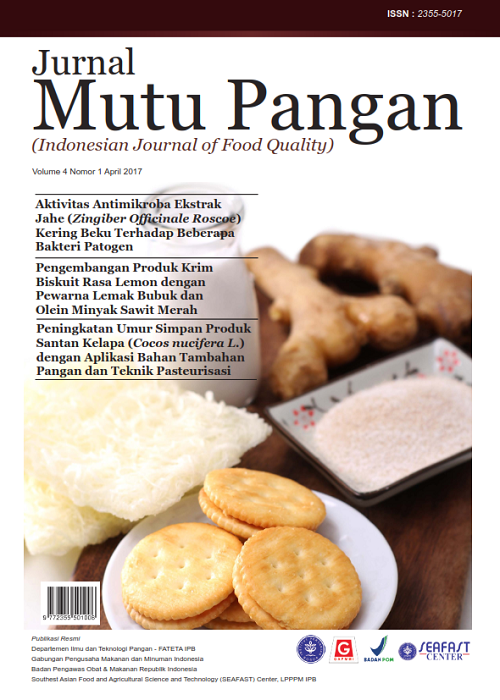Evaluasi Profil Sensori Sediaan Pemanis Komersial Menggunakan Metode Check-All-That-Apply (CATA)
Abstract
Table-top sweetener is sweeteners in the form of granule, powder, tablet or liquid ready to be consumed as final product are packed in disposable packaging. CATA is a simple and valid tools for gathering information about food products based on consumer perception. There were two steps in CATA method: a panelist selection part and a sensory testing part. The objective of this study were to (1) profiled sensory characteristics of ideal sweetener and commercial table-top sweeteners by non-diabetic and diabetic panelists, (2) identified the panelist preferences mapping for commercial table-top sweeteners, and (3) identified the potential sensory attributes in table-top sweetener development. CATA analysis results with XLSTAT 2016 software indicates that perception ideal sweeteners by non-diabetic panelists have a sensory profile that sweet, sweet aftertaste, body and cooling. A, B, and D come closest to the ideal sweetener. Meanwhile perception ideal sweetener by diabetic panelists have a sensory profile that sweet and body. D come closest to ideal sweetener. D is the most favored product by non-diabetic and diabetic panelists, because D get a preference value above the average from all panelists. There is no correlation between the sensory attributes and panelist preference that significant at 5% sign level, it means that there is no table-top sweetener sensory attributes that control panelist preference significantly. In product development, table-top sweeteners for non-diabetic consumer must not have a bitter aftertaste and nice to have a sweet aftertaste. Meanwhile table top sweeteners for diabetic consumer must have a body attribute but not significant at 5% test level.
Downloads
References
[AMI] Applied Market Information. 2001. Market share of non-calorie sweeteners in China and Indonesia. http://www.foodreview.co.id. [November 2015].
Adams J, Williams A, Lancaster B, Foley M. 2007. Ad-vantages and Uses of Check-All-That-Apply Responces Compared to Traditional Scaling of Attributes for Salty Snacks. 7th Pangborn Sensory Science Symposium, Minneapolis.
Ares G, Barreio C, Deliza R, Gimenez A, Gambaro A. 2010. Application of a check-all-that-apply question to the development of chocolate milk desserts. J Sen Stu 25: 67-86. DOI: 10.1111/j.1745-459X.2010. 00290.x.
Bustos SR, Alfaro RM, de la Luz SRM, Trujillo HB, Pacheco CM, Vázquez JC, Ade JCD. 2009. Taste sensitivity diminution in hyperglycemic type 2 diabetics patients. Rev Med Inst Mex Seguro Soc 47: 483–488.
[BPOM] Badan Pengawas Obat dan Makanan. 2014. Keputusan Kepala Badan Pengawas Obat dan Makanan Republik Indonesia No: HK. 00.05.5.1. 4547 tentang Persyaratan Penggunaan Bahan Tam-bahan Pangan Pemanis Buatan dalam Produk Pangan.
Deis CR. 2006. Customizing sweeteners profile. Food Product Design 15: 1-5.
Dooley L, Lee YS, Meullenet JF. 2010. The application od check-all-thatapply (CATA) consumer profiling to ppreference mapping of vanilla ice cream and its comparison to classical external preference mapp-ing. Food Quality Preference 21: 395-401. DOI: 10.1016/ j.foodqual.2009.10.002.
Effendi S, Tukiran. 2012. Metode Penelitian Survei. LP3ES, Jakarta.
Giacalone D, Wender LP, Bredie, Frost MB. 2013. All-In-One Test (AI1): A rapid and easily applicable approach to consumer product testing. Food Quality Preference 27: 108-119. DOI: 10.1016/j.foodqual. 2012.09.011.
Gondivkar SM, Indurkar A, Degwekar S, Bhowate R. 2009. Evaluation of gustatory function in patients with diabetes mellitus type 2. Oral Surg Oral Med Oral Pathol Oral Radiol Endod 108: 876–880. DOI: 10.1016/j.tripleo.2009.08.015.
LMC International and The NutraSweet Company. 2010. Market Share of Noncaloric Sweeteners. LMC International and The NutraSweet Company Estimate.
Meyners M, Castura JC, Carr BT. 2013. Existing and new approaches for the analysis of CATA data. Foor Quality Preference 30: 309-319. DOI: 10.10 16/j. foodqual.2013.06.010.
Mitchel H. 2006. Sweetener and Sugar Alternative in Food Technology. Blackwell Publishing Ltd, UK. DOI: 10.1002/9780470996003.
Nabors LO. 2016. Alternative Sweeteners Fourth Edition. CRC Press, Newyork.
Pick M. 2010. Sugar substitutes and the potential danger of Splenda. http://www.dorway.com/stevia.html. [Juli 2016].
Plaehn D. 2012. CATA penalty/reward. Food Quality Preference 24: 141-152. DOI: 10.1016/j.foodqual. 2011.10.008.
Raini M, Isnawati A. 2011. Kajian: khasiat dan keamanan stevia sebagai pemanis pengganti gula. Media Litbang Kesehatan 21: 145-156.
Varela P, Ares G, Gimenez A, Gambaro A. 2010. Influence of brand information on consumers expectations and liking of powdered drinks in central location tests. Food Quality Preference 21: 873-880. DOI: 10.1016/j.foodqual.2010.05.012.
XLSTAT. 2016. CATA data analysis. http://www.xlstat. com/en/solutions/features/cata. [Februari 2016].

















